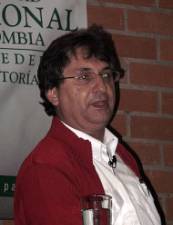

Position: PhD student
Email: glvasque@unal.edu.co
Universidad Nacional de Colombia
Sede Medellín
Facultad de Ciencias Agropecuarias
Depto de Ciencias Forestales
Colombia

Supervisors and collaborators:
Duration: 2012-2016
Funding: Smurfit Kappa Cartón de Colombia S.A.; Universidad Nacional de Colombia, Sede Medellín; VU University
Large tracts of montane rain forests and cloud forests in the Central Andes of Colombia have been transformed to grasslands whose top-soils over the years have been subject to degradation and compaction. The hydrological impacts of this degradation at the catchment scale are poorly known. To meet the country's growing demands for timber and pulp, pasture land is being converted to fast-growing tree plantations (mostly eucalypts); the hydrological impacts of which are as yet undocumented. To fill this important gap in regional hydrological knowledge, this project aims to quantify the hydrological response of small headwater basins under more or less undisturbed lower montane rain forest, long-term pasture, and eucalypt plantation near Santa Rosa de Cabal, Rosa de Cabal, in the Western part of the Central Cordillera of Colombia. The selected catchments have similar size, orientation, altitudinal range and geological substrate. Apart from a survey of soil physical conditions, hillslope- and catchment runoff response to rainfall will be studied under the respective land-cover types using stable isotope and chemical end member analytical techniques to elucidate runoff contributions from different sources. Future work on plantation water use (rainfall interception and transpiration) is envisaged as well.